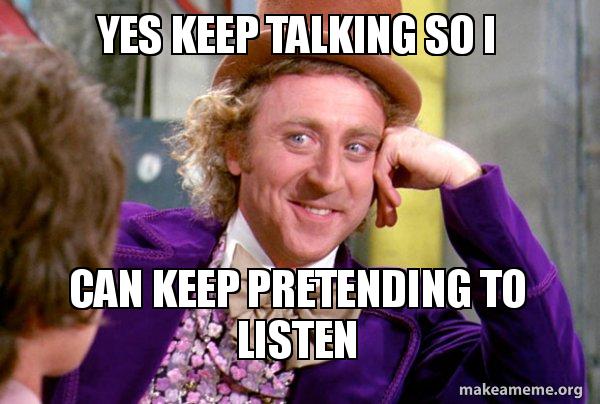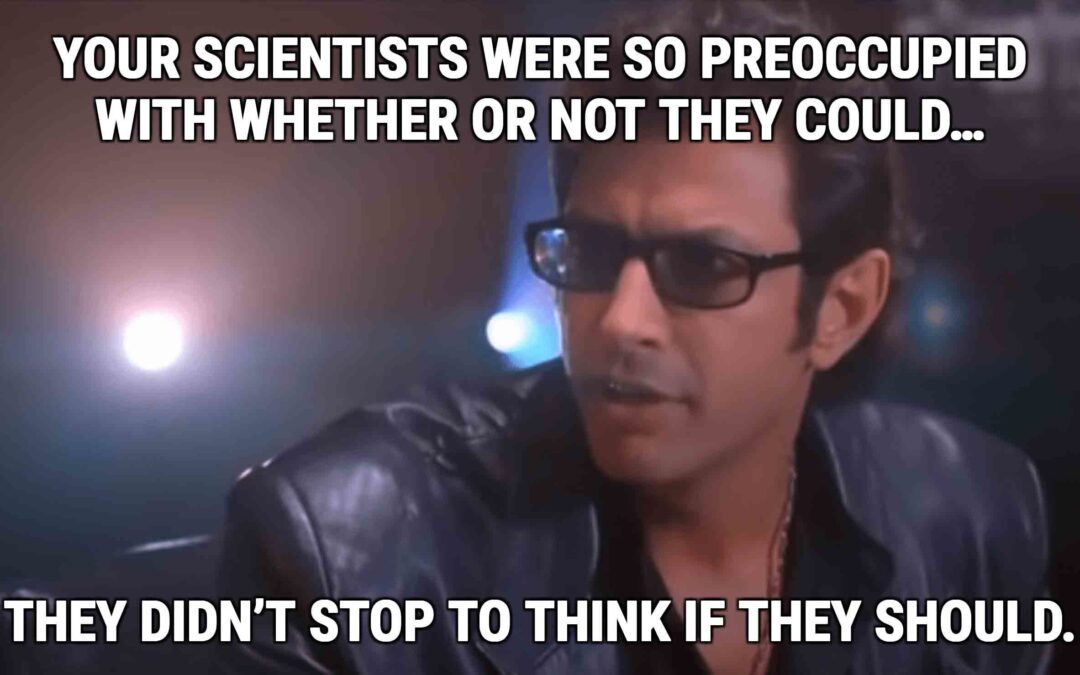
by Robyn Bolton | Oct 19, 2023 | Innovation, Leadership
AI is killing Corporate Innovation.
Last Friday, the brilliant minds of Scott Kirsner, Rita McGrath, and Alex Osterwalder (plus a few guest stars like me, no big deal) gathered to debate the truth of this statement.
Honestly, it was one of the smartest and most thoughtful debates on AI that I’ve heard (biased but right, as my husband would say), and you should definitely listen to the whole thing.
But if you don’t have time for the deep dive over your morning coffee, then here are the highlights (in my humble opinion)
Why this debate is important
Every quarter, InnoLead fields a survey to understand the issues and challenges facing corporate innovators. The results from their Q2 survey and anecdotal follow-on conversations were eye-opening:
- Resources are shifting from Innovation to AI: 61.5% of companies are increasing the resources allocated to AI, while 63.9% of companies are maintaining or decreasing their innovation investments
- IT is more likely to own AI than innovation: 61.5% of companies put IT in charge of exploring potential AI use cases, compared to 53.9% of Innovation departments (percentages sum to greater than 0 because multiple departments may have responsibility)
- Innovation departments are becoming AI departments. In fact, some former VPs and Directors of Innovation have been retitled to VPs or Directors of AI
So when Scott asked if AI was killing Corporate Innovation, the data said YES.
The people said NO.
What’s killing corporate innovation isn’t technology. It’s leadership.
Alex Osterwalder didn’t pull his punches and delivered a truth bomb right at the start. Like all the innovation tools and technologies that came before, the impact of AI on innovation isn’t about the technology itself—it’s about the leaders driving it.
If executives take the time to understand AI as a tool that enables successful outcomes and accelerates the accomplishment of key strategies, then there is no reason for it to threaten, let alone supplant, innovation.
But if they treat it like a shiny new toy or a silver bullet to solve all their growth needs, then it’s just “innovation theater” all over again.
AI is an Inflection Point that leaders need to approach strategically
As Rita wrote in her book Seeing Around Corners, an inflection point has a 10x impact on business, for example, 10x cheaper, 10x faster, or 10x easier. The emergence and large-scale adoption of AI is, without doubt, an inflection point for business.
Just like the internet and Netscape shook things up and changed the game, AI has the power to do the same—maybe even more. But, to Osterwalder’s point, leaders need to recognize AI as a strategic inflection point and proceed accordingly.
Leaders don’t need to have it all figured out yet, but they need a plan, and that’s where we come in.
This inflection point is our time to shine
From what I’ve seen, AI isn’t killing corporate innovation. It’s creating the biggest corporate innovation opportunity in decades. But it’s up to us, as corporate innovators, to seize the moment.
Unlike our colleagues in the core business, we are comfortable navigating ambiguity and uncertainty. We have experience creating order from what seems like chaos and using innovation to grow today’s business and create tomorrow’s.
We can do this because we’ve done it before. It’s exactly what we do,
AI is not a problem. It’s an opportunity. But only if we make it one.
AI is not the end of corporate innovation —it’s a tool, a powerful one at that.
As corporate innovators, we have the skills and knowledge required to steer businesses through uncertainty and drive meaningful change. So, let’s embrace AI strategically and unlock its full potential.
The path forward may not always be crystal clear, but that’s what makes it exciting. So, let’s seize the moment, navigate the chaos, and embrace AI as the innovation accelerant that it is.

by Robyn Bolton | Oct 11, 2023 | Customer Centricity, Innovation, Leadership
You know that customer insights are important.
You spend time and money to collect customer insights.
But are you using them?
And by “using,” I don’t mean summarizing, synthesizing, discussing, PowerPointing, and presenting the insights. I mean making decisions, changing strategies, and rethinking plans based on them.
I posed this question to a few dozen executives. The awkward silence spoke volumes.
Why do we talk to customers but not listen to them?
In a world of ever more constrained resources, why do we spend our limited time and money collecting insights that we don’t use meaningfully?
It seems wild to have an answer or an insight and not use it, especially if you spent valuable resources getting it. Can you imagine your high school self paying $50 for the answer key to the final in your most challenging class, then crumpling it up, throwing it away, and deciding to just wing the exam?
But this isn’t an exam. This is our job, profession, reputation, and maybe even identity. We have experience and expertise. We are problem solvers.
We have the answers (or believe that we do).
After all, customers can’t tell us what they want. We’re supposed to lead customers to where they should be. Waiting for insights or changing decisions based on what customers think slows us down, and isn’t innovation all about “failing fast,” minimal viable products, and agility?
So, we talk to customers because we know we should.
We use the answers and insights to ensure we have brilliant things to tell the bosses when they ask.
We also miss the opportunity to create something that changes the game.
But it doesn’t have to be this way.
What do you NEED to learn?
It’s easy to rattle off a long list of things you want to learn from customers. You probably also know the things you should learn from customers. But what do you need to learn?
What do you need to know by the end of a conversation so that you can make a decision?
What is the missing piece in the puzzle that, without it, you can’t make progress?
What insight do you need so badly that you won’t end the conversation until you have it?
If the answer is “nothing,” why are you having the conversation?
Will you listen?
Hearing is the “process, function, or power of perceiving a sound,” while listening is “hearing things with thoughtful attention” and a critical first step in making a connection. It’s the difference between talking to Charlie Brown’s teacher and talking to someone you care about deeply. One is noise, the other is meaning.
You may hear everything in a conversation, but if you only listen to what you expect or want to hear, you’ll miss precious insights into situations, motivations, and social dynamics.
If you’re only going to listen to what you want to hear, why are you having the conversation?
Are you willing to be surprised?
We enter conversations to connect with others, and the best way to connect is to agree. Finding common ground is exciting, comforting, and reassuring. It’s great to meet someone from your hometown, who cheers for the same sports team, shares the same hobby, or loves the same restaurant.
When we find ourselves conversing with people who don’t share our beliefs, preferences, or experiences, our survival instincts kick in, and we fight, take flight, or (like my client) freeze.
But here’s the thing – you’re not being attacked by a different opinion. You’re being surprised by it. So, assuming you’re not under actual physical threat, are you willing to lean into the surprise, get curious, ask follow-up questions, and seek to understand it?
If you’re not, why are you having the conversation?
Just because you should doesn’t mean you must.
You know that customer insights are important.
You spend time and money to collect customer insights.
But are you using them to speed the path to product-market fit, establish competitive advantage, and create value?
If you’re not, why are you having the conversation?

by Robyn Bolton | Oct 4, 2023 | Innovation, Leadership, Stories & Examples
“Lego’s Latest Effort to Avoid Oil-Based Plastic Hits Brick Wall” – WSJ
“Lego axes plans to make bricks from recycled bottles” – BBC
“Lego ditches oil-free brick in sustainability setback” – The Financial Times
Last Monday, LEGO found itself doing the Walk of Atonement after announcing to The Financial Times that it was scrapping plans to make bricks from recycled bottles, and media outlets from The Wall Street Journal to Fast Company to WIRED were more than happy to play the Shame Nun.
And it wasn’t just media outlets ringing the Shame Bell:
- “In the future, they should not make these kinds of announcements (prototype made from recyclable plastic) until they actually do it,” Judith Enck, President of Beyond Plastics
- “They are not going to survive as an organization if they don’t find a solution,” Paolo Taticchi, corporate sustainability expert at University College London.
- “Lego undoubtedly had good intentions, but if you’re going to to (sic) announce a major environmental initiative like this—one that affects the core of your company—good intentions aren’t enough. And in this instance, it can even undermine progress.” Jesus Diaz, creative director, screenwriter, and producer at The Magic Sauce, writing forFast Company
As a LEGO lover, I am not unbiased, but WOW, the amount of hypocritical, self-righteous judgment is astounding! All these publications and pundits espouse the need for innovation, yet when a company falls even the tiniest bit short of aspirations, it’s just SHAME (clang) SHAME (clang) SHAME.
In 1946, LEGO founder Ole Kirk Christiansen purchased Denmark’s first plastic injection molding machine. Today, 95% of the company’s 4,400 different bricks are made using acrylonitrile butadiene styrene (ABS), a plastic that requires 4.4 pounds of oil to produce 2.2 pounds of brick. Admittedly, it’s not a great ratio, and it gets worse. The material isn’t biodegradable or easily recyclable, so when the 3% of bricks not handed down to the next generation end up in a landfill, they’ll break down into highly polluting microplastics.
With this context, it’s easy to understand why LEGO’s 2018 announcement that it will move to all non-plastic or recycled materials by 2030 and reduce its carbon emissions by 37% (from 2019’s 1.2 million tons) by 2032 was such big news.
Three years later, in 2021, LEGO announced that its prototype bricks made from polyethylene terephthalate (PET) bottles offered a promising alternative to its oil-based plastic bricks.
But last Monday, after two years of testing, the company shared that what was promising as a prototype isn’t possible at scale because the process required to produce PET-based bricks actually increases carbon emissions.
SHAME!
A LEGO Art World Map (i.e. massive) amount of praise for LEGO
LEGO is doing everything that innovation theorists, consultants, and practitioners recommend:
- Setting a clear vision and measurable goals so that people know what the priorities are (reduce carbon emissions), why they’re important (“playing our part in building a sustainable future and creating a better world for our children to inherit”), and the magnitude of change required
- Defining what is on and off the table in terms of innovation, specifically that they are not willing to compromise the quality, durability, or “clutch power” of bricks to improve sustainability
- Developing a portfolio of bets that includes new materials for products and packaging, new services to keep bricks out of landfills and in kids’ hands, new building and production processes, and active partnerships with suppliers to reduce their climate footprint
- Prototyping and learning before committing to scale because what is possible at a prototype level is different than what’s possible at pilot, which is different from what’s possible at scale.
- Focusing on the big picture and the long-term by not going for the near-term myopic win of declaring “we’re making bricks from more sustainable materials” and instead deciding “not to progress” with something that, when taken as a whole process, moves the company further away from its 2032 goal.
If we want companies to innovate (and we do), shaming them for falling short of perfection is the absolute wrong way to do it.
Is it disappointing that something that seemed promising didn’t work out? Of course. But it’s just one of many avenues and experiments being pursued. This project ended, but the pursuit of the goal hasn’t.
Is 2 years a long time to figure out that you can’t scale a prototype and still meet your goals? Maybe. But, then again, it took P&G 10 years to figure out how to develop and scale a perforation that improved one-handed toilet paper tearing.
Should LEGO have kept all its efforts and success a secret until everything was perfect and ready to launch? Absolutely not. Sharing its goals and priorities, experiments and results, learnings and decisions shows employees, partners, and other companies what it means to innovate and lead.
Is LEGO perfect? No.
Is it trying to be better? Yes.
Isn’t that what we want?

by Robyn Bolton | Sep 27, 2023 | Innovation, Stories & Examples
In the room were two single beds, each with a fluffy white comforter folded neatly on top.
“Yeah, this is not gonna work.”
I had just entered my one-bedroom corporate apartment in Copenhagen, and while everything else was pleasantly light and spacious, there was no way I would spend the next six months sleeping in a single bed.
So, I set down my suitcases and immediately pushed the two beds together, using the two nightstands to secure them. The two comforters would work since there was just one of me, and I made a mental note to request a king-sized comforter from the desk when I left for work in the morning.
Thus began the great Comforter Cold War of 2006/2007.
Every few days, I would request a king-sized comforter for my jerry-rigged king-sized bed. I would return to find one queen-sized comforter. The luxury of a larger comforter would diminish the disappointment of not getting an appropriately sized one, and I would bask in the warmth of fully covered sleep. For one night. The next day, I would return to my room only to find that the two single comforters had returned.
This went on for nine months.
I shared this story of passive-aggressive housekeeping at my going away party with my colleagues. Midway through the story, I noticed the absolutely baffled looks on their faces.
“What?”
“Why did you want one comforter?”
“Because I have one bed. A comforter should cover the bed.”
“Why? A bed doesn’t need a comforter. A person does. You just need a comforter to cover you.”
[extended silence while we try to process each other’s points]
“So, does that mean that in Denmark, if a couple sleeps together, they each have their own comforter?”
“Yes, of course! Why would we share? Each person has their own temperature preferences, and there’s no worry about someone stealing your covers.”
My mind. Was. Blown.
This made so much sense. A comforter covers a person, so the 1:1 ratio of comforter to people is far more logical than a 1:1 ratio of comforter to bed (and often a 1:2 ratio of comforter to people). Seriously, how many relationships would be saved by simply having separate comforters?
Yet, for nine months, it made more sense to me to battle for a comforter size that apparently doesn’t exist in the country without ever asking why I couldn’t get what I was so clearly and reasonably (in my mind) requesting.
I assumed the apartment building didn’t have king-sized comforters or only enough for the actual king-sized beds. I assumed housekeeping was on automatic pilot, not realizing they were replacing a queen-sized comforter with two single ones. I assumed that communication amongst the staff was poor, so my request wasn’t being shared. I assumed a lot.
But I never assumed that I was wrong and that the root of the problem was a cultural difference so deeply ingrained and subtle that it never occurred to anyone to question it.
Question your assumptions.
Assumptions are a shortcut to understanding our world. Based on culture, experiences, and even stereotypes, we make assumptions about what came before, who we’re interacting with, what’s happening now, and what will happen next.
Most of the time, we’re right (or at least more right than wrong), so we keep making assumptions. It’s also why, when our assumptions are wrong, we tend to question everything but our assumptions.
And that kills innovation because it limits our curiosity and imagination, our perception of what’s possible, and our willingness to engage with and learn from others.
We all cling to assumptions that lead to Cold Wars.
What’s yours?

by Robyn Bolton | Sep 18, 2023 | Customer Centricity, Innovation
“If you can’t explain something simply, you don’t understand it well enough.”
Albert Einstein (supposedly)
This is one of my favorite quotes because it’s an absolute gut punch. You think you know something, probably because you’ve been saying and doing it for years. Then someone comes along and asks you to explain it, and suddenly, you’re just standing there, mouth agape, gesturing, hoping that this wacky game of charades produces an answer.
This happened to me last Monday.
While preparing to teach a course titled “Design Innovation Lab,” I thought it would be a good idea to define “design” and “innovation.” I already had a slide with the definition of “innovation” – something new that creates value – but when I had to make one for “design,” my stomach sank.
My first definition was “pretty pictures,” which is both wrong and slightly demeaning because designers do that and so much more. My second definition, I know it when I see it, was worse.
So, I Googled the definition.
Then I asked ChatGPT.
Then I asked some designer friends.
No one had a simple definition of Design.
As the clock ticked closer to 6:00 pm, I defaulted to a definition from the International Council of Design:
“Design is a discipline of study and practice focused on the interaction between a person – a “user” – and the man-made environment, taking into account aesthetic, functional, contextual, cultural, and societal considerations. As a formalized discipline, design is a modern construct.”
Before unveiling this definition to a classroom full of degreed designers pursuing their Master’s in Design, I asked them to define “design.”
It went as well as all my previous attempts. Lots of thoughts and ideas. Lots of “it’s this but not that.” Lots of debate about whether it needs to have a purpose for it to be distinct from art.
Absolutely no simple explanations or punchy definitions.
So, when I unveiled the definition from the very official-sounding International Council of Design, we all just stared at it.
“Yes, but it’s not quite right.”
“It is all those things, but it’s more than just those things.”
“I guess it is a ‘modern construct’ when you think of it as a job, but we’ve done it forever.”
As we squinted and puzzled, what was missing slowly dawned on us.
There was nothing human in this definition. There was no mention of feelings or empathy, life or nature, connection or community, aspirations or dreams.
In this definition, designers consider multiple aspects of an unnatural environment in creating something to be used. Designers are simply the step before mass production begins.
Who wants to do that?
Who wants to be a stop, however necessary, on a conveyor belt of sameness?
Yet that’s what we become when we strip the humanness out of our work.
Humans are messy, emotional, unpredictable, irrational, challenging, and infuriating.
We’re also interesting, creative, imaginative, hopeful, kind, curious, hard-working, and resilient.
When we try to strip away human messiness to create MECE (mutually exclusive, collectively exhaustive) target markets and customer personas, we strip away the human we’re creating for.
When we ignore unpredictable and irrational feedback on our ideas, we ignore the creative and imaginative answers that could improve our ideas.
When we give up on a challenge because it’s more difficult than expected and doesn’t produce immediate results, we give up hope, resiliency, and the opportunity to improve things.
I still don’t have a simple definition of design, but I know that one that doesn’t acknowledge all the aspects of a human beyond just being a “user” isn’t correct.
Even if you explain something simply, you may not understand it well enough.

by Robyn Bolton | Sep 11, 2023 | Innovation
Why are people so concerned about, afraid of, or resistant to new things?
Innovation, by its very nature, is good. It is something new that creates value.
Naturally, the answer has nothing to do with innovation.
It has everything to do with how we experience it.
And innovation without humanity is a very bad experience.
Over the last several weeks, I’ve heard so many stories of inhuman innovation that I have said, “I hate innovation” more than once.
Of course, I don’t mean that (I would be at an extraordinary career crossroads if I did). What I mean is that I hate the choices we make about how to use innovation.
Just because AI can filter resumes doesn’t mean you should remove humans from the process.
Years ago, I oversaw recruiting for a small consulting firm of about 50 people. I was a full-time project manager, but given our size, everyone was expected to pitch in and take on extra responsibilities. Because of our founder, we received more resumes than most firms our size, so I usually spent 2 to 3 hours a week reviewing them and responding to applicants. It was usually boring, sometimes hilarious, and always essential because of our people-based business.
Would I have loved to have an AI system sort through the resumes for me? Absolutely!
Would we have missed out on incredible talent because they weren’t out “type?” Absolutely!
AI judges a resume based on keywords and other factors you program in. This probably means that it filters out people who worked in multiple industries, aren’t following a traditional career path, or don’t have the right degree.
This also means that you are not accessing people who bring a new perspective to your business, who can make the non-obvious connections that drive innovation and growth, and who bring unique skills and experiences to your team and its ideas.
If you permit AI to find all your talent, pretty soon, the only talent you’ll have is AI.
Just because you can ghost people doesn’t mean you should.
Rejection sucks. When you reject someone, and they take it well, you still feel a bit icky and sad. When they don’t take it well, as one of my colleagues said when viewing a response from a candidate who did not take the decision well, “I feel like I was just assaulted by a bag of feathers. I’m not hurt. I’m just shocked.”
So, I understand ghosting feels like the better option. It’s not. At best, it’s lazy, and at worst, it’s selfish. Especially if you’re a big company using AI to screen resumes.
It’s not hard to add a function that triggers a standard rejection email when the AI filters someone out. It’s not that hard to have a pre-programmed email that can quickly be clicked and sent when a human makes a decision.
The Golden Rule – do unto others as you would have done unto you – doesn’t apply to AI. It does apply to you.
Just because you can stack bots on bots doesn’t mean you should.
At this point, we all know that our first interaction with customer service will be with a bot. Whether it’s an online chatbot or an automated phone tree, the journey to a human is often long and frustrating. Fine. We don’t like it, but we don’t have a choice.
But when a bot transfers us to a bot masquerading as a person? Do you hate your customers that much?
Some companies do, as my husband and I discovered. I was on the phone with one company trying to resolve a problem, and he was in a completely different part of the house on the phone with another company trying to fix a separate issue. When I wandered to the room where my husband was to get information that the “person” I was talking to needed, I noticed he was on hold. Then he started staring at me funny (not as unusual as you might think). Then he asked me to put my call on speaker (that was unusual). After listening for a few minutes, he said, “I’m talking to the same woman.”
He was right. As we listened to each other’s calls, we heard the same “woman” with the same tenor of voice, unusual cadence of speech, and indecipherable accent. We were talking to a bot. It was not helpful. It took each of us several days and several more calls to finally reach humans. When that happened, our issues were resolved in minutes.
Just because innovation can doesn’t mean you should allow it to.
You are a human. You know more than the machine knows (for now).
You are interacting with other humans who, like you, have a right to be treated with respect.
If you forget these things – how important you and your choices are and how you want to be treated – you won’t have to worry about AI taking your job. You already gave it away.





